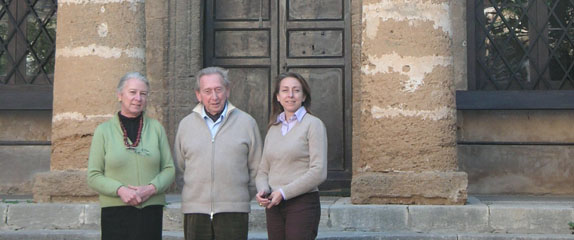World of CookingArrive a tourist, eat your mistakes, go home with recipes for a feast
MENFI, Italy — We weave our way out of the densely packed city of Palermo at rush hour and drive south through western Sicily. The road slices through a valley surrounded by huge rocky outcroppings. The sky is a deep blue and green fields stretch ahead like a velvet patchwork bordered by a riot of orange, red, and yellow wildflowers. On a hillside, a herd of sheep is so tightly clustered, it looks like a giant ball of moving yarn.
Our destination is the coastal village of Menfi, an easy 1 1/2-hour drive away, to attend a class on Sicilian cooking taught by Natalia Ravidà and experience an olive oil tasting. Off the highway, at the end of the main road, sits the family’s 18th-century neoclassical villa. The sea is just beyond and the smell of salt fills the air. We enter the gates and park in the outer courtyard.
Ravidà is a former journalist and now cookbook author, entrepreneur in the family’s award-winning olive oil business, wife, and mother. She will share her family’s culinary heritage for the next several hours in flawless English.
Joining me is Nunzia Radenmeyer, a South African whose parents emigrated from Sicily when she was a teenager. Like me, she is a cooking teacher. We both thought it would be great to be the students this time.
On our way to the kitchen, we pass a long marble table surrounded by cast iron chairs where we will take our lunch. A large wooden frame window is splayed open so we can see into the kitchen. Across the courtyard, under a tiled overhang and atop a huge grinding stone cum table, we will do the olive oil tasting. Usually, the tasting is done on the Gurra farm, elsewhere on the estate, where students tour the olive groves and see how the oil is processed.
We will be cooking in the home kitchen — well equipped but not commercial. Although you are in the hands of a professional, it feels as if a group of friends has gathered to prepare a meal. A wooden spoon is propped inside an antique crock of the Ravidàs’ own sea salt from local salt flats. Well-worn copper pots hang from a cast iron rack on a long white wall. The ingredients for the dishes are organized by recipe and laid out on an oval marble island in the center of the kitchen. We gather around as Ravidà explains the day’s recipes. She introduces Sicilian cuisine by tracing the influences of some of the many civilizations that came through this storied island — Phoenicians, Greeks, Arabs, Normans, and Spaniards.
She stresses the importance of seasonal ingredients. With recipes in hand, we begin. Ravidà divides up tasks.
We start to chatter and to help each other. Tears run down Radenmeyer’s cheeks as she cuts the onions that will go into a sweet and sour sauce. The pit of a black olive shoots across the table as I press too hard on its flesh with the broad side of my knife. Fresh sardine fillets lie glistening next to a plate of homemade bread crumbs, waiting for a light dusting.
Ravidà begins to fill a wok with olive oil to deep-fry hollowed-out eggplants. More surprising than finding a wok in rural Sicily is her using such an expensive oil for deep frying. She explains that good olive oil cooked at such a high temperature can be reused. And she reminds us that the better the oil, the less greasy the food. After several minutes, she removes the eggplants and prepares to stuff them with anelletti, little pasta rings, in homemade tomato sauce.
As we arrange our handiwork on platters, kitchen assistants begin to clean up and set the table. Our stomachs are rumbling, but lunch will have to wait.
First, to the courtyard and the tasting. Six bottles of olive oil and a bunch of little white plastic cups are on a tray on the stone table. Ravidà explains the differences among grades of oil and helps us to understand why one bottle may cost $5 and another $40. We learn about the proper storage of oil and how it can spoil.
She pours about a tablespoon of oil in a cup and demonstrates how to take the oil into the mouth — sliding it to the back of the tongue where our taste buds register both bitter and spicy flavors. I don’t think I mastered the right swishing motion, but I didn’t get it all over myself, either.
The tasting begins with rancid olive oil. Whew, is that bad! She introduces successively higher grades, and we begin to discern differences. ”The better the oil the more peppery and bitter it tastes in the back of your mouth,” Ravidà explains. By the time we get to her oil, with its peppery surge and light velvety texture, the difference in quality is clear. I cannot claim to have tasted ”a hint of fresh mown grass,” as described in a review of Ravidà oil, but it was wonderful and I had an entirely new appreciation. The award-winning Ravidà oil is exported worldwide.
Finally it is time to eat. The atmosphere is informal and friendly. The table is laid with local ceramics. We begin with a crisp Sicilian white wine and the sardine fillets. We raise our glasses to Ravidà, who declares ”Buon appetito,” and serve ourselves, family style. We enjoy the baked eggplant stuffed with pasta alongside a very colorful dish of roasted peppers with a caper, olive, and mint sauce. On another platter is pan-fried mackerel with a sweet and sour onion sauce. A large bowl of linguine is tossed with cherry tomatoes, olives, and capers, and a colorful fennel salad with black olives and oranges completes the entrees. For dessert, we enjoy a refreshing gelatin made from mandarin orange juice and its grated rind. The warm spring sun and the wine are working their magic. We could linger forever.
We tour the rest of the house and it is obvious that this was once a grand villa. While it is still elegant, some rooms need repair. Costly renovations to the chipped frescoes on vaulted ceilings and fading wallpapers are underway, and there is scaffolding on the rear of the house. Ravidà’s explanation of the project is fascinating. The layers of the family’s history peel away before your eyes.
You can spend anywhere from a day up to a week at Villa Ravidà. They are flexible and willing to accommodate your interests. Besides cooking classes and olive oil tastings, there is pizza making at the farm, and guided tours can be arranged to visit surrounding towns and local markets. You will be given a quote based on the package you choose and on the number of people in your party. There is a two-person minimum. Classes run April to July and September to November.
The villa can accommodate up to 10 people. We didn’t stay overnight, but the rooms, some of which are in what once were stables, are spotless, if somewhat spare and on the small side. All have a private bathroom with shower. A continental breakfast, served in the villa’s dining room, is included. There are many places to sit and sip an aperitivo or read a book when you are not cooking or tasting. This is one kind of rural tourism that is changing the way we think about taking an Italian holiday.












 Debra Samuels, bestselling author, food writer and cooking instructor,
Debra Samuels, bestselling author, food writer and cooking instructor,